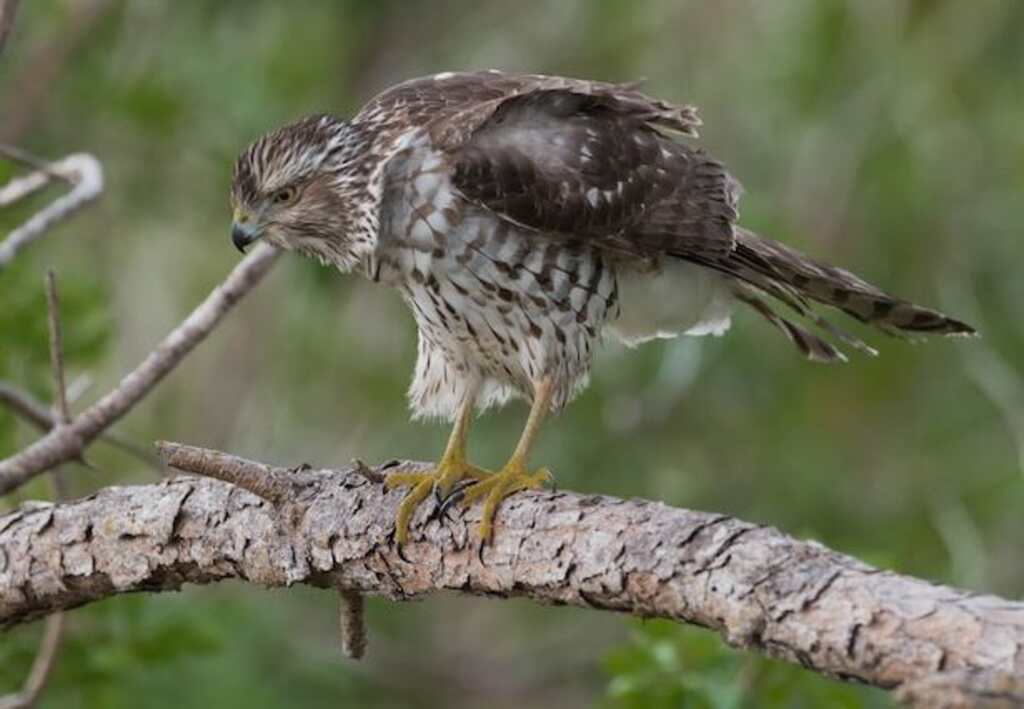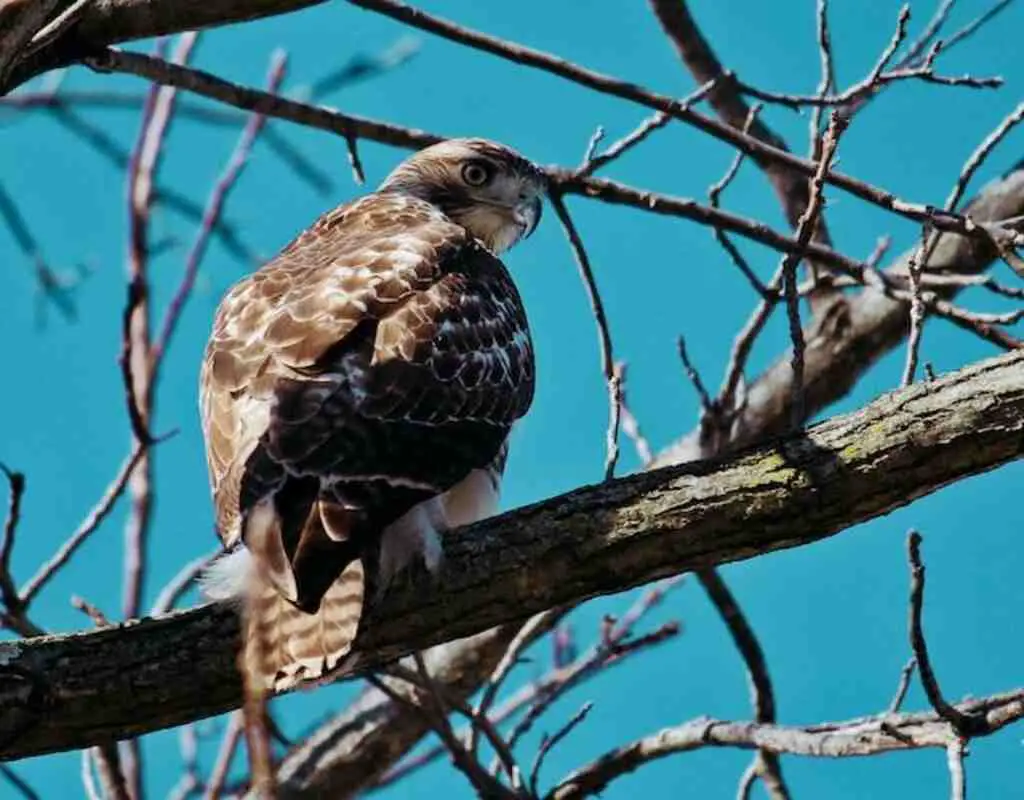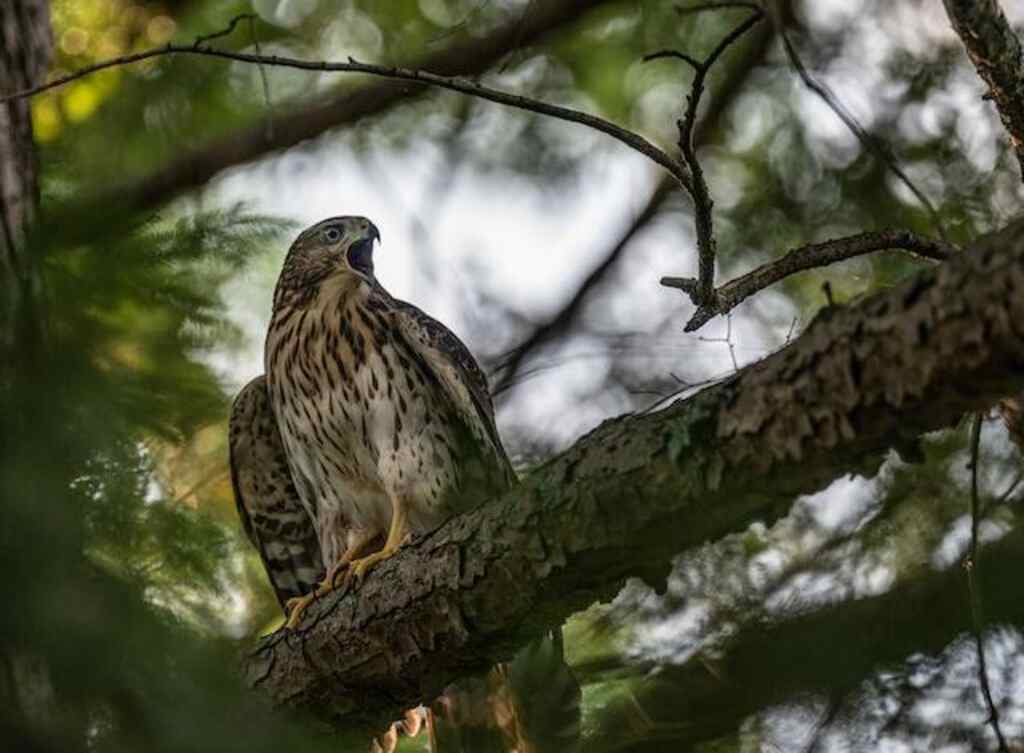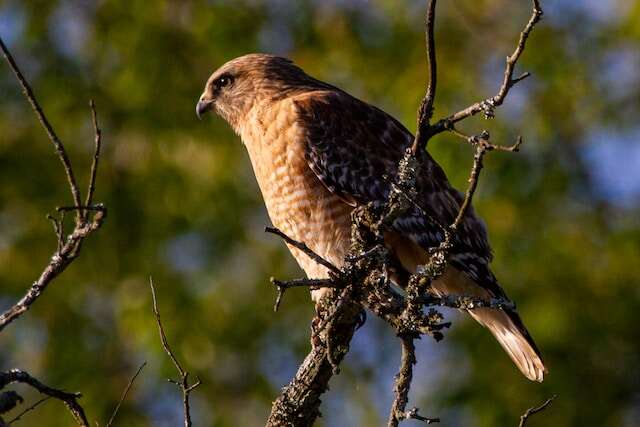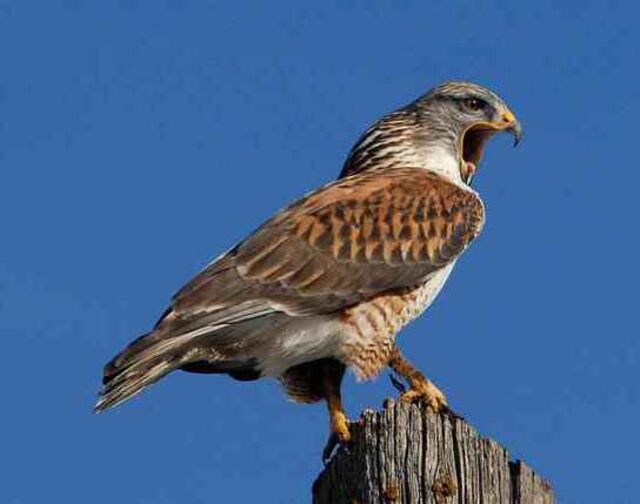How Do Hawks Avoid Predators? The sky is their playground, but even mighty hawks have their own predator problems.
These skilled hunters have devised some awe-inspiring tricks up their feathers to outsmart the dangers that lurk in their ecosystem.
From airborne acrobatics to ingenious camouflage, join us as we unravel the secrets of how these majestic birds stay one step ahead in the game of survival.
Get ready to soar into the fascinating world of hawk defenses!
Table of Contents
- 1 The Importance of Avoiding Predators
- 2 Physical Adaptations
- 3 How Do Hawks Avoid Predators?
- 4 Behavioral Tactics
- 5 Habitat Selection
- 6 Social Dynamics
- 7 Physical Adaptations
- 8 Behavioral Tactics
- 9 Habitat Selection
- 10 Social Dynamics
- 11 Conclusion
- 12 FAQs: How Do Hawks Avoid Predators?
- 12.1 How do hawks avoid predators?
- 12.2 What physical adaptations help hawks avoid predators?
- 12.3 Do hawks fly at high altitudes to avoid predators?
- 12.4 Do hawks hunt in groups for protection?
- 12.5 How do hawks use surprise attacks on prey?
- 12.6 Do hawks choose specific habitats to avoid predators?
- 12.7 How do hawks use social dynamics to protect themselves?
- 12.8 Are hawks monogamous birds?
- 12.9 How do hawks select nesting sites to avoid predators?
- 12.10 Why is predator avoidance important for hawks?
- 13 Author
The Importance of Avoiding Predators
Avoiding predators is crucial for hawks because they rely on their hunting skills to survive.
If a hawk becomes preyed upon, not only does it lose its life, but also its chances of reproducing and continuing its species’ survival.
Hawks must also be cautious because they face various threats from other animals in their ecosystem.
For example, larger raptors such as eagles or owls may attack hawks for territorial reasons or competition over resources.
Physical Adaptations
Hawks have various physical adaptations that help them defend against predators. Their sharp talons and beaks enable them to grab onto prey while fending off attackers if necessary.
Their excellent eyesight allows them to spot potential threats from great distances away.
In addition to these physical adaptations, some hawk species have feathers with patterns that help them blend into their surroundings and avoid detection by predators or prey alike.
The Northern Harrier is an example of a hawk species with feather patterns that provide effective camouflage.
How Do Hawks Avoid Predators?
Hawks employ various strategies to avoid predators. They possess exceptional vision, allowing them to spot potential threats from afar.
Their agility in flight enables them to swiftly evade danger. Hawks also utilize camouflage techniques and select nesting sites that provide cover.
These adaptations and behaviors help hawks stay one step ahead of their predators.
Behavioral Tactics
Hawks have developed several behavioral tactics to avoid becoming prey themselves.
For instance, hawks may fly at high altitudes to avoid ground-based predators like foxes or coyotes, who cannot climb up trees or cliffs where hawks tend to nest.
Some hawk species also hunt in groups, which offers added protection against potential threats.
Cooper’s hawks, for example, are known for their cooperative hunting strategies and may team up to catch larger prey or defend themselves against larger predators.
Hawks may use surprise attacks on prey when hunting to avoid being detected by other predators. This tactic also helps them avoid competing with other animals for food resources.
Habitat Selection
Hawk’s habitat selection is another way they use to avoid predators. Hawks usually choose to nest sites in hard-to-reach locations such as cliffs or tall trees where ground-based predators cannot reach them easily.
They will also avoid areas with high predator populations, such as areas with large populations of raccoons or coyotes.
Social Dynamics
Hawks have complex social dynamics that help them protect themselves and their young from potential threats.
For example, hawks have mating strategies that involve defending territory and nests from other hawks and predators alike.
Some hawk species require both parents’ involvement in raising their young, which means they share the responsibility of protecting their offspring from danger.
Physical Adaptations
Hawks have several physical adaptations that help them avoid becoming prey. Their sharp talons and beaks, for instance, allow them to defend themselves against potential predators and also help them capture prey.
Hawks use their talons to grip onto their prey tightly, while their powerful beaks can tear through flesh with ease.
These weapons allow hawks to fight off potential attackers or kill prey efficiently. Another physical adaptation that helps hawks avoid predators is their excellent eyesight.
Hawks have some of the best eyesight in the animal kingdom, which allows them to spot potential threats from far away. Their eyes are specially designed for hunting and detecting movement up to a mile away.
This keen sense of sight helps hawks identify potential dangers before they get too close. Camouflage feathers also play an important role in helping hawks avoid predators.
Hawks have evolved with feathers that help them blend into their surroundings, making it harder for predators to spot them when they’re perched or hunting.
The mottled brown coloration on a hawk’s feathers resembles the bark of trees or rocks on cliffs where they like to perch waiting for prey.
This camouflage helps protect hawks from aerial predators such as owls.
The feathers on a hawk’s head are also unique and designed for survival purposes; they grow backward along the head instead of forward, allowing wind and rain to roll off reducing weight and improving survival rate during inclement weather conditions.
In addition, hawks have evolved with feather tufts called “ear” tufts on either side of their face which serve no hearing purpose but may intimidate competitors by giving an appearance of increased size.
Overall, these physical adaptations enhance a hawk’s ability to survive attacks from other animals while hunting or defending territory.
Behavioral Tactics
While physical adaptations are crucial to the hawk’s survival, behavioral tactics also play an essential role in avoiding predators.
Flying at High Altitudes to Avoid Ground-Based Predators
Hawks have mastered the skill of flying at high altitudes to avoid ground-based predators. Hawks, especially those that hunt during the day, soar as high as possible to evade ground predators like foxes and coyotes.
Flying higher than their natural habitat also allows them to spot prey from a greater distance. In addition, hawks’ ability to fly high is essential for their migration route.
They use thermal currents (rising columns of warm air) that rise from the ground to soar upward into the sky without flapping their wings continuously.
This technique saves energy and allows them to cover vast distances while returning home or migrating for food.
When using this tactic, hawks must be careful not to fly too high and fall prey themselves.
Hunting in Groups for Added Protection
Hawks are solitary hunters by nature; however, some species hunt in groups for added protection against predators or larger prey items.
Cooper’s hawks and goshawks are two species known for hunting cooperatively with other birds of prey. Group hunting involves each bird taking on a specific role.
One hawk may act as a “flusher,” flushing out prey from hiding locations while others wait nearby ready to catch it.
Another bird may act as a “chaser,” pursuing any escaped prey so that another bird can take over when it tires out.
The effectiveness of group hunting depends on communication between individual hawks involved in the hunt through vocalizations, such as whistles and high-pitched calls.
This tactic allows hawks to take on larger prey than they would typically tackle alone.
Using Surprise Attacks on Prey to Avoid Being Detected by Other Predators
Hawks use surprise attacks to avoid being detected by other predators who might steal their prey. Hawks’ wings are specially designed for silent flight, allowing them to swoop down and capture their prey without making a sound.
Additionally, hawks often approach their prey from the sun’s direction or even fly upside down to get behind it and attack suddenly before the target realizes what’s happening.
By using these tactics, hawks can catch their prey off guard while avoiding detection by other predators.
While physical adaptations provide hawks with an advantage in hunting and protecting themselves from predators, behavioral tactics also play a crucial role in their survival.
Through flying at high altitudes, hunting in groups for added protection, and using surprise attacks on prey, hawks have developed various strategies to evade predators successfully.
Habitat Selection
Choosing Nesting Sites
One of the ways hawks avoid predators is by choosing nesting sites in hard-to-reach locations. For example, many species of hawks prefer to nest on cliffs or tall trees, which can be difficult for predators to access.
This provides an added layer of security for both the adult hawks and their young chicks.
In addition to choosing high-up locations, hawks also look for areas that provide ample protection from the elements and potential predators.
This may include areas with good visibility, where they can spot potential threats from afar.
Hawks also tend to prefer areas with minimal human activity, as disturbances can disrupt their nesting and increase the risk of predation.
Camouflaged Nesting Sites
Some species of hawks go even further to protect their nests by choosing camouflage locations.
For example, some species will build their nests in trees that closely match the color and texture of their feathers.
This makes it much more difficult for predators (such as raccoons or coyotes) to spot the nest from below.
Avoiding Areas with High Predator Populations
Another way hawks avoid becoming prey is by avoiding areas with high predator populations. Hawks are often at risk of predation themselves, so they must be extremely cautious when selecting hunting grounds or nesting sites.
To minimize this risk, many hawks actively seek out low-predator-density habitats where they will be less likely to encounter danger.
For example, some species may avoid habitats where there are large numbers of raccoons or coyotes – both common hawk predators.
Interestingly enough, some studies have suggested that certain hawk species may even have an innate sense for identifying areas with low-predator-density habitats.
This has been observed in both captive and wild populations – demonstrating just how important predator avoidance strategies are for the survival of many hawk species.
Selective Nesting Habits and Mating Strategies
In addition to avoiding high-predator-density habitats, hawks may also employ selective nesting habits and mating strategies to avoid becoming prey.
For example, some species may choose to mate with partners that are particularly adept at protecting their young – increasing the chances of survival for their offspring.
Additionally, some hawk species may actively defend their territory against other birds of prey – further reducing the risk of predation by eliminating potential competitors.
This can be seen in hawks that occupy a specific hunting area or region year after year – resulting in the exclusion of other predator populations.
All in all, habitat selection is a crucial aspect of how hawks avoid becoming prey.
By carefully choosing where they nest and hunt, these impressive birds are able to reduce their risk of predation and increase their chances of survival in even the most challenging environments.
Social Dynamics
Mating Strategies
Hawks are monogamous birds, meaning they mate with the same partner for life. This relationship is crucial when it comes to defending territory and nests from other hawks and predators.
During breeding season, hawks become extremely territorial, often engaging in aerial battles with rival males or females vying for the same mate.
These fights can be dangerous and sometimes fatal for the birds involved.
In addition to fighting off rival hawks, mating pairs of hawks must also defend their nests from other predators such as raccoons, squirrels, and snakes.
To do this, they often use a combination of physical attacks and vocalizations to scare off potential threats.
Parenting Strategies
Once the eggs have been laid, both male and female hawks share responsibility for incubating them until they hatch.
Once the chicks have hatched, both parents continue to work together to provide food and protection for their young.
In some cases where food is scarce or predators are particularly active in an area, one parent may stay with the chicks while the other hunts.
As the chicks grow older and more self-sufficient, both parents teach them essential survival skills such as hunting techniques and predator avoidance strategies.
This process can take several months before the young hawk is ready to leave the nest on its own.
Overall, this collaborative parenting strategy helps ensure that young hawks have a better chance of survival in their first few months of life, when they are most vulnerable to predators.
Conclusion
Hawks have developed an impressive array of strategies to avoid becoming prey themselves while also providing protection for their offspring against other predators.
From physical adaptations like sharp talons and keen eyesight to behavioral tactics like flying at high altitudes or hunting in groups – every aspect of a hawk’s life is focused on survival.
Although they are skilled hunters, hawks must constantly be aware of potential threats and adapt their behavior accordingly.
Whether fighting off rival birds during breeding season or defending their nests from predators year-round, these birds have a deep instinct for self-preservation that has allowed them to thrive in many different habitats and regions of the world.
Understanding these social dynamics of hawks can provide valuable insights into how other species interact with each other and with their environment.
As we continue to study these fascinating creatures, we may gain a deeper understanding of the delicate balance that exists between predator and prey – and how we can work to protect both in the wild.
FAQs: How Do Hawks Avoid Predators?
How do hawks avoid predators?
Hawks avoid predators through a combination of physical adaptations and behavioral tactics. They have sharp talons, excellent eyesight, and camouflage feathers to defend themselves and blend into their surroundings. They fly at high altitudes, hunt in groups, and use surprise attacks on prey to avoid detection by other predators.
What physical adaptations help hawks avoid predators?
Hawks have sharp talons and beaks for self-defense and capturing prey. Their exceptional eyesight allows them to spot potential threats from afar. Camouflage feathers help them blend into their surroundings, making it harder for predators to spot them when perched or hunting.
Do hawks fly at high altitudes to avoid predators?
Yes, hawks fly at high altitudes to avoid ground-based predators like foxes and coyotes. Flying higher also allows them to spot prey from a greater distance. They use thermal currents and their keen sense of balance to soar upward into the sky without continuous wing flapping, conserving energy while staying safe from predators.
Do hawks hunt in groups for protection?
Some hawk species, like Cooper’s hawks and goshawks, hunt in groups for added protection. They coordinate their hunting strategies, with specific roles assigned to each bird. Group hunting allows them to tackle larger prey and defend themselves against larger predators more effectively.
How do hawks use surprise attacks on prey?
Hawks use surprise attacks to catch prey off guard and avoid being detected by other predators. They have silent flight capabilities, allowing them to swoop down on prey without making a sound. They may approach prey from the sun’s direction or even fly upside down to launch sudden and unexpected attacks.
Do hawks choose specific habitats to avoid predators?
Yes, hawks choose nesting sites in hard-to-reach locations such as cliffs or tall trees, making it difficult for predators to access them. They also select areas with low predator populations and ample visibility. Habitat selection plays a crucial role in minimizing the risk of predation and ensuring their survival.
Hawks have complex social dynamics that aid in predator avoidance. During breeding season, they defend their territory and nests from rival hawks and other predators through physical attacks and vocalizations. Both parents actively participate in parenting, sharing the responsibility of protecting their young from potential threats.
Are hawks monogamous birds?
Yes, hawks are monogamous, meaning they mate with the same partner for life. This lifelong bond is crucial for defending territories and nests from other hawks and predators. Mating pairs engage in aerial battles with rivals, demonstrating their commitment to protecting their offspring.
How do hawks select nesting sites to avoid predators?
Hawks choose nesting sites in hard-to-reach locations, such as cliffs or tall trees, to reduce the risk of predation. Some species build nests in trees that match their feather color and texture, camouflaging them from predators below. They also avoid areas with high predator populations.
Why is predator avoidance important for hawks?
Predator avoidance is vital for hawks because it ensures their survival and the continuation of their species. By evading predators, hawks can maintain their position at the top of the food chain, fulfill their ecological role in controlling smaller animal populations, and successfully raise their offspring to contribute to the next generation.

